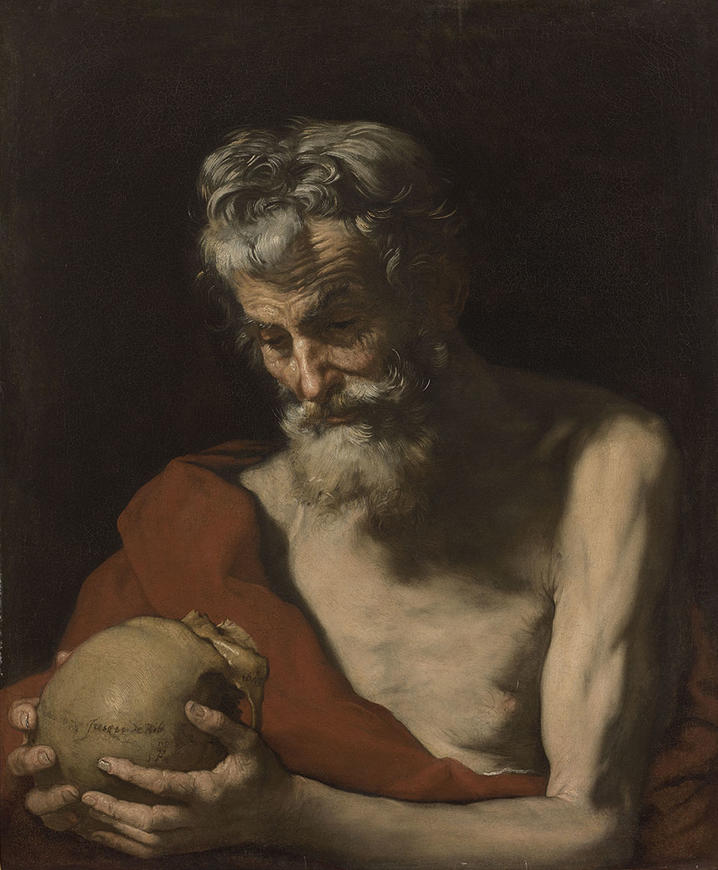Jerome is one of the four great Doctors of the Church, alongside Augustine, Ambroise and Gregory the Great. Having studied Greek and Latin, he retired to the desert to do penance. Upon his return, he was charged with translating the Bible into Latin, known as the Vulgate.
He is often represented as a bearded, half-naked hermit. As the legend goes, he also wore a red coat and a cardinal's hat, though he never held this position. The lion, the skull and the book are other attributes linked to certain episodes of his history.
The hermit saints are a favourite subject in the paintings of José de Ribera. Saint Jerome is represented in his work some 40 times! In this version, from the artist's later years, the figure appears as a bust in a tight frame and in a small format. The saint concentrates on the skull, his only meditation object. The saint is represented with none of the other attributes of his traditional panoply. Reduced to its most simple expression, his representation reflects man facing his destiny. Here, the simple evocation of the cult of penitence is transcended!
This stripped-back work presents a naturalist style: Ribera's painting offers a physical sense of the reality of the material, while contrasting lighting brings a sense of gravity to the scene.
Detail 1: The artist's signature and the date of it's creation, 1643, can be seen on the skull held by the saint.
Detail 2: In a painting held in the Lille Palais des Beaux-Arts, Artus Wolfort, a contemporary of Rubens, represents the saint with his traditional attributes: the wounded lion he has healed and the Bible he translated into Latin, the Vulgate, known as the Church's official version. The whip, the skull and the crucifix are the hermit's instruments of penitence.

Jerome is one of the four great Doctors of the Church, alongside Augustine, Ambroise and Gregory the Great. Having studied Greek and Latin, he retired to the desert to do penance. Upon his return, he was charged with translating the Bible into Latin, known as the Vulgate.
He is often represented as a bearded, half-naked hermit. As the legend goes, he also wore a red coat and a cardinal's hat, though he never held this position. The lion, the skull and the book are other attributes linked to certain episodes of his history.
The hermit saints are a favourite subject in the paintings of José de Ribera. Saint Jerome is represented in his work some 40 times! In this version, from the artist's later years, the figure appears as a bust in a tight frame and in a small format. The saint concentrates on the skull, his only meditation object. The saint is represented with none of the other attributes of his traditional panoply. Reduced to its most simple expression, his representation reflects man facing his destiny. Here, the simple evocation of the cult of penitence is transcended!
This stripped-back work presents a naturalist style: Ribera's painting offers a physical sense of the reality of the material, while contrasting lighting brings a sense of gravity to the scene.
Detail 1: The artist's signature and the date of it's creation, 1643, can be seen on the skull held by the saint.
Detail 2: In a painting held in the Lille Palais des Beaux-Arts, Artus Wolfort, a contemporary of Rubens, represents the saint with his traditional attributes: the wounded lion he has healed and the Bible he translated into Latin, the Vulgate, known as the Church's official version. The whip, the skull and the crucifix are the hermit's instruments of penitence.